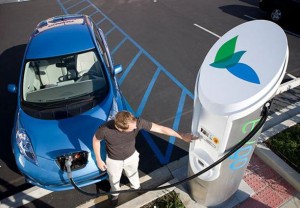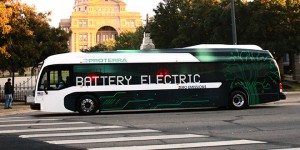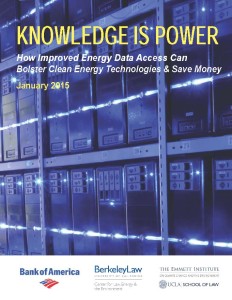 There are a number of misconceptions about electric vehicles. Like the battery is toxic and the mining for battery materials is destructive, so the cars aren’t great for the environemt (not true — they have a comparatively minimal environmental footprint and the batteries can be recycled or repurposed).
There are a number of misconceptions about electric vehicles. Like the battery is toxic and the mining for battery materials is destructive, so the cars aren’t great for the environemt (not true — they have a comparatively minimal environmental footprint and the batteries can be recycled or repurposed).
Or these cars are just for bigshots and celebrities like Brad Pitt (not true — lots of cheap lease deals out there, and the Nissan LEAF is under $20,000 in California after incentives).
Or electricity is a dirty fuel, too, so you’re not really helping the environment by switching to it from gas.
Okay, that last one is actually partially true. In states that are heavily dependent on burning coal for electricity, you’re better off driving a hybrid, if all you care about is air pollution. But those are just about eight states in the upper plains, like North Dakota and Iowa. And it’s still good to drive an EV there, just not great. Meanwhile, everywhere else it’s an environmental slam-dunk.
But even better news: given the improved efficiency of the vehicles, with longer range and better technology, coupled with coal power being swapped out for natural gas plants and more renewables, the environmental equation for electric vehicles is getting better and better.
As Green Car Reports noted late last year, a recent Union of Concerned Scientists study has upgraded the numbers to show significant improvements across the country. In states like California, EVs get the equivalent of almost 100 miles per gallon, while in “bad” states with coal, the numbers are 35 to 39 miles per gallon and getting better.
So in a few years, as prices come down, more of us will be able to do that cross-country all-electric drive for cheap — and without environmental guilt.
Batteries are key to reducing greenhouse gas emissions. We simply can’t avert massive climate change without them. Why? They will power our vehicles, instead of gas. They will store surplus renewable power when the sun isn’t shining and the wind isn’t blowing. And they can allow neighborhoods to go “off grid” entirely via microgrids, with neighborhood battery packs capturing surplus renewable power generated on-site, and no more need for electric utilities.
But the problem has always been that batteries are too expensive.
Now a new study by Björn Nykvist & Måns Nilsson in the journal Nature Climate Change (subscription only) shows remarkable progress on price. Keep in mind that the magic number to make batteries cost-competitive and enable long-distance, cheap electric vehicle batteries is about $150 per kilowatt hour (kWh):
We show that industry-wide cost estimates declined by approximately 14% annually between 2007 and 2014, from above US$1,000 per kWh to around US$410 per kWh, and that the cost of battery packs used by market-leading BEV [battery electric vehicle] manufacturers are even lower, at US$300 per kWh, and has declined by 8% annually. Learning rate, the cost reduction following a cumulative doubling of production, is found to be between 6 and 9%, in line with earlier studies on vehicle battery technology. We reveal that the costs of Li-ion battery packs continue to decline and that the costs among market leaders are much lower than previously reported.
While this is a bit wonky sounding, it’s significant. We’re seeing solid price declines each year and getting closer to that magic number of $150/kWh. While it’s unlikely we’ll see a sudden, massive drop in prices like we did with solar, this pace should mean that in another decade or so, electric vehicles could be widespread and the norm. And then renewable power can truly decarbonize our electricity sector by coupling with cheap batteries.
But we must maintain the federal and state incentives for batteries that we currently have in place, and then we can slowly phase them out as we approach that magic number. Those incentives include federal investment tax credits, federal and state tax credits and cash rebates for electric vehicles, and various grant funding for demonstration battery projects.
Without those incentives, this progress could be arrested before it reaches that magic price number. But for the time being, we have real reason for hope.
Call it Kyoto Syndrome, but each year for the past few decades we hear hopeful things about the upcoming negotiations for the “United Nations Framework Convention on Climate Change.” These discussions usually take place in some far-flung world capital, and they unfailingly result in a nothing sandwich. In 2009, President Obama humiliated himself with a last-ditch flight to Copenhagen to try to hammer out something meaningful.
And like clockwork this year, hopes seem to be higher than normal that something might actually get accomplished in Paris in December (that is, other than the convention attendees enjoying themselves after-hours in the cafes and tourist sites in the City of Lights).
Mercifully, Ruth Greenspan Bell dispenses with the fiction that a meaningful international agreement is either feasible or likely to make a difference if one were to actually get signed. In an article for Georgetown International Environmental Law Review (PDF), she questions the assumptions underlying these talks:
Negotiators have, apparently, uncritically accepted the proposition that a huge basket of climate-related issues—each of them very complex and requiring for their execution the cooperation of many parties with often wildly disparate views—can (indeed, must) be resolved in one comprehensive agreement. They also assume that such agreements, should they be signed and ratified, will lead to assured changes in the GHG emission practices of the many parties to the agreement.
It’s worth reading the piece in full, but in short, Bell traces the history of multilateral agreements in the environmental context and notes the tremendous uncertainty about their effectiveness. And the greenhouse gas problem is arguably even more difficult to tackle than some of the past agreements that addressed single pollutants with often straightforward technology fixes or alternatives. She also points out how challenging the UN process is to reaching an agreement, with its requirement for consensus, the huge number of parties involved, and the incredible political diversity and needs of the countries at the table. And by focusing so much on ratification, the process is in danger of reaching an agreement with little enforceability or monitoring of compliance.
Meanwhile, time is running out on our ability to stabilize the Earth’s climate.
Given the urgency, Bell offers some alternatives that could actually achieve reductions sooner. Most importantly, we need to forget about a comprehensive agreement and instead bite off more manageable international agreements, akin to the progress made in the international weapons arena. For example, major emitter nations could come to terms on pollution targets among themselves; developing countries could negotiate over reduced amount of emissions reductions; and bilateral agreements, such as the recent one between China and the U.S., might pave the way for future agreements between other countries.
Overall, I believe that the solution to global climate change will come locally, from technology, policy, and financing innovations that happen within places like California, China and Germany. But at some point we will need a global approach to limiting carbon to reflect the true cost of this pollution to our economy, health, and environment. I’d much prefer that we engage in that process in a way that will actually achieve results, rather than spinning our wheels on the international stage each year.
As my Legal Planet colleague Rick Frank blogged, the California Supreme Court on Wednesday granted review of San Diego’s really bad regional transportation plan. I detail the history here, but basically San Diego’s regional transportation agency delivered a plan in 2011 that was supposed to comply with SB 375 (Steinberg, 2008), a landmark law linking transportation spending with long-term greenhouse gas emission reductions.
Instead, San Diego’s agency issued a plan that projected reductions in vehicle miles traveled only in the short run, via accounting gimmicks like more telecommuting and estimated smoother traffic flows from highway widening. And then the plan actually showed backsliding on emissions going out to 2050.
Petitioners argued successfully at the trial and appellate court level that this backsliding contravened California’s long-term policy on greenhouse gases, specifically Governor Schwarzenegger’s 2005 executive order calling for an 80% reduction in greenhouse gas emissions from 1990 levels by 2050. Notably, the state’s 2006 climate legislation, AB 32, only discussed a 2020 greenhouse gas target.
But will this case already be moot by the time the court decides it? There are two reasons to think so:
First, San Diego is already well into its second transportation plan in the post-SB 375 world, which presumably will be much stronger than its 2011 version. That version was already in process when SB 375 was enacted and was the first out of the gate in California to have to comply with the new law.
Second, the California Legislature is currently debating a series of bills that could solidify California’s long-term greenhouse gas emissions reduction goals. If those goals get legislated, particularly ones out to 2050, then a debate over whether the 2005 executive order is legally enforceable in this instance becomes moot.
Of course, a win for the plan’s opponents will only strengthen the hand of advocates for better, more sustainable transportation and land use planning. It will force SB 375 plans to contemplate real, meaningful changes in land use and transportation decision-making, because these greenhouse gas reductions will have to be permanent and cumulative. And it will bolster efforts by public officials in other contexts to reduce long-term greenhouse gas emissions in order to comply with the California Environmental Quality Act, which this case is based on.
So in the end, I hope the court upholds the lower court decision. But I also hope the case becomes moot with legislative action this year.
I often feel that hard core transit advocates deep down hate electric vehicles. I’ve heard comments to that effect, that EVs are just a shiny new product to justify avoiding building new urban environments and encouraging people to walk, bike, or take transit. Plus, many transit advocates simply hate cars, for the danger they pose to pedestrians and bikers, the physical distance they put between people and divide communities, and the environmental destruction they cause by enabling sprawl and polluting the skies.
 But as someone focused on greenhouse gas reduction, I am a big EV booster. It won’t solve everything, but we need to switch out of petroleum and to bring more investment in battery technologies, which EVs provide. It’s just not realistic to think that everyone can move into an urban, non-automobile environment or that we can entirely retrofit our car-centric built environment in time to avoid climate catastrophe.
But as someone focused on greenhouse gas reduction, I am a big EV booster. It won’t solve everything, but we need to switch out of petroleum and to bring more investment in battery technologies, which EVs provide. It’s just not realistic to think that everyone can move into an urban, non-automobile environment or that we can entirely retrofit our car-centric built environment in time to avoid climate catastrophe.
So for all the EV haters who love transit, maybe they will love Proterra’s new 180-mile range electric bus:
The extended-range Catalyst XR is available in configurations carrying between 129 kWh and 321 kWh of energy storage, and can be recharged in a little over an hour.
“Operating successfully in cities across the country, the Proterra Catalyst is the most energy-efficient transit bus on the market,” said Proterra VP Matt Horton. “Adding extended-range capabilities to our existing portfolio of fast-charge products enables us to help our customers meet more of their most demanding service requirements. The flexibility of our platform allows our customers to more confidently invest in the future of transit.”
Who wouldn’t love a silent, clean and smooth-accelerating bus in their neighborhood? Plus, those batteries could be repurposed for bulk energy storage, while potentially charging at key times when renewable energy is at surplus. And perhaps most importantly, they pay for themselves pretty quickly through saved fuel costs, leaving more transit funds for other purposes.
This could be a kumbaya moment for EV and transit advocates.
 UC Berkeley and UCLA Schools of Law will be hosting a free legislative lunch briefing next Tuesday on expanding access in California to clean energy data, the subject of the Knowledge is Power report that the law schools released last month. The energy data could include improved customer access to long-term usage patterns, utility statistics on distribution grid needs and pricing, and anonymized, aggregated energy usage patterns on a neighborhood scale. The goal is to help boost California’s clean technology industries and reduce costs for ratepayers, while ensuring that the state can more cost-effectively meet its climate and energy goals.
UC Berkeley and UCLA Schools of Law will be hosting a free legislative lunch briefing next Tuesday on expanding access in California to clean energy data, the subject of the Knowledge is Power report that the law schools released last month. The energy data could include improved customer access to long-term usage patterns, utility statistics on distribution grid needs and pricing, and anonymized, aggregated energy usage patterns on a neighborhood scale. The goal is to help boost California’s clean technology industries and reduce costs for ratepayers, while ensuring that the state can more cost-effectively meet its climate and energy goals.
WHEN: Tuesday, February 24th, 11:45am to 1:15pm (registration begins at 11:30am)
Lunch will be served, followed by the keynote address at noon
WHERE: Room 125, California State Capitol Building, Sacramento, CA 95814
Keynote Address:
The Honorable Andrew McAllister, Commissioner, California Energy Commission
Panel presentation:
Michael Murray, Chief Technology Strategist, Mission:data & President, Lucid
Lisa Schmidt, President and CEO, Home Energy Analytics
RSVP by Friday, February 20th at this link. Space is limited to the first 40 people who register, due to the size of the room.
This event is presented by the UC Berkeley and UCLA Schools of Law Climate Change and Business Research Initiative to develop policies that help businesses prosper in an era of climate change. Funding for this initiative is provided by Bank of America.
Forget AB 32, now it’s all about SB 32. With the state well on its way to achieving our greenhouse gas reduction goals by 2020, California legislators unveiled yesterday new 2030 goals, with the one letter change in the main bill’s title understating the significance:
On Monday, Democratic lawmakers in the state unveiled a package of four bills that aim to tackle climate change in the state. One of the bills, SB 350, calls for a 50 percent reduction in petroleum use in cars and trucks, a 50 percent increase in energy efficiency in buildings, and a goal of 50 percent of state utilities’ power coming from renewable energy, all by 2030. Current California law requires utilities get 33 percent of their energy from renewable sources, such as wind and solar, by 2050. SB 350’s goals are virtually the same as the ones called for by California Gov. Jerry Brown in his inaugural address in January.
The legislation, if passed (as seems likely given the strong Democratic majorities in both houses), would have significant immediate effects. First, it would help boost the renewables market, which has been stalled of late due to its present trajectory being on course to meet or exceed the 2020 33% goals. With so many projects in the pipeline, utilities have little incentive to keep procuring unless a new target is legislated.
Second, it will help lawsuits like the one against SANDAG in San Diego, with its weak transportation plan that shows emissions increases out to 2050. The lawsuit hinges on the plan (and its environmental review documentation) not complying with the state’s 2050 goals. But those goals are only an executive order from Governor Schwarzenegger. With legislation underfoot, the challenge to the case has a much stronger chance of surviving state supreme court review.
Finally, it will provide more certainty to all the climate change efforts underway, particularly the cap-and-trade program, which would otherwise expire in 2020. With legislation, industry will know what to expect going forward, and revenue for things like affordable housing near transit, energy efficiency upgrades, and high speed rail, will be dependable for years to come.
Let’s hope the legislation can face a clear path to adoption, without getting watered down by special interest giveaways.
I haven’t read her book This Changes Everything: Capitalism vs. The Climate, but I finally caught her interview with Bill Maher back in September (I can’t embed the video but it’s available at that link). I certainly like her focus on climate change and critique of what endless resource exploitation has done to the planet. But I can’t help but feel that climate change for her just presents more evidence in support of her agenda for wholesale economic reform — namely, rolling back capitalism in some undefined way to punish big businesses and allow the rest of us to live more collectively.
And as a result, you get interviews like this one, where she spends over eight minutes talking in vague generalities about the limits of capitalism but not offering any constructive solutions — perhaps other than encouraging Harvard to divest from coal and polluters to pay (for what spending purposes she doesn’t say). Instead, she attacks a “liberal” strawman for claiming that we can solve the environmental problems of our day by simply changing light bulbs and driving hybrids.
As someone who works closely with dedicated policy makers in California and beyond who are quite serious and focused on reducing our greenhouse gas emissions, I don’t recognize her caricature at all. No climate change fighters that I know of would argue that we can reduce our emissions sufficiently just by making easy fixes. Certainly switching to LED light bulbs and driving efficient cars can make an important difference, but we need fundamental changes in our energy system, including massive deployment of renewables, smart grid/demand response technologies, electric vehicles and energy storage, as well as much more housing and jobs located near robust transit systems, with greater energy efficiency throughout our economy.
But maybe Klein doesn’t want to talk about these wholesale, technology-based solutions because they rely very much on our capitalist system. Indeed, California incentives have sparked a competitive, capitalist gold rush to deploy renewables at a rapid scale, as well as electric vehicles and more recently energy storage. We’re trying to do the same for sustainable real estate developers but are limited by local control over land use, which too often are determined by the loudest NIMBYs in any community.
To be sure, California’s program involves some sticks that Klein might like — regulations on the carbon content of fuel, limits (if not de facto bans) on heavy emitters like cement manufacturers, and a cap-and-trade program that adds costs to carbon polluters like fuel providers and other manufacturers.
But ultimately, unless we want to deindustrialize and shiver in the dark, it’s going to take a new, focused capitalism to rescue us from the excesses of the old. And that’s a reality that Klein should acknowledge, unless she has a better plan she wants to unveil.
California is raking in the bucks from its cap-and-trade program. Sales from auctioning off permits to pollute will net the state close to $900 million in this budget year, and it could go to $8 billion a year by 2020, now that transportation fuels are firmly under the cap. Of that amount, about half is dedicated to transportation and infill development that can reduce greenhouse gas emissions. Here is the breakdown on that piece of it:
Transit Capital: $25 million (10% of total auction revenue)
Transit Operations: $25 million (5% of total revenue)
Housing & Sustainable Communities: $130 million (20%)
High Speed Rail: $250 million (25%)
The rest will go to wetland restoration, energy efficiency upgrades for public buildings, and recycling efforts.
 But it’s that $130 million piece that’s been in the news recently (it’s actually $120 million, due to an additional $10 million set-aside for agricultural projects). Called the Affordable Housing and Sustainable Communities (AHSC) Program, state agencies have been trying to adopt the guidelines for disbursing these funds for meritorious land use and transportation projects for over a year. That process was finalized a few weeks ago by the Strategic Growth Council, which issued a complicated set of criteria for project proponents to be eligible to apply.
But it’s that $130 million piece that’s been in the news recently (it’s actually $120 million, due to an additional $10 million set-aside for agricultural projects). Called the Affordable Housing and Sustainable Communities (AHSC) Program, state agencies have been trying to adopt the guidelines for disbursing these funds for meritorious land use and transportation projects for over a year. That process was finalized a few weeks ago by the Strategic Growth Council, which issued a complicated set of criteria for project proponents to be eligible to apply.
According to the new guidelines [PDF], half of the funded projects must provide affordable housing near transit, while the other half must provide benefits for “disadvantaged communities,” per this map.
But the problem is (at least for this first round), $120 million won’t get you very far. Affordable housing projects have a minimum grant award of $1 million and maximum of $15 million, while transit projects in disadvantaged communities have a minimum $500 thousand and maximum $8 million. You can see how that money will go quickly with only $120 million to disburse. As Streetsblog LA reported, Strategic Growth Council staff “expect to be able to fund between 15 and 25 projects in the first round.”
15 to 25 projects is, frankly, not much. And not much to get excited about in this first round. Fortunately, more money will be available later this year in the second round, and an expanding pot of auction funds could mean almost 10 times this amount in a few years, if the $8 billion-by-2020 projection comes true.
But even at 10 times this amount (over $1 billion a year), that’s just a couple hundred projects per year — not enough to make up for the loss of redevelopment funds. These funds were a primary source of infill financing, and the program netted about $5 billion annually statewide until it self-immolated in a 2011 California Supreme Court case.
I hate to be a Debbie Downer, but California will need to do better than this given the extreme housing needs in the state. It’s hard not to look jealously at the high speed rail set-aside and wonder why more of that money is not flowing to transit-oriented housing. After all, high speed rail was sold as a viable public-private investment that would essentially pay for itself. But after voter approval, the route was politically gerrymandered to accommodate powerful political interests. The politically motivated route changes to Palmdale and the eastern San Joaquin Valley drove up the price tag due to more complicated construction, reduced travel speeds between the major population centers, and made the project less attractive to private investors.
Perhaps as more constituents get a taste of cap-and-trade dollars, it will put political pressure on Sacramento leaders to retool the formulas to give more money to transit-oriented housing. It won’t happen while Governor Brown is in office, given his attachment to high speed rail as a legacy project, but I wouldn’t be surprised if it happens before 2020.



